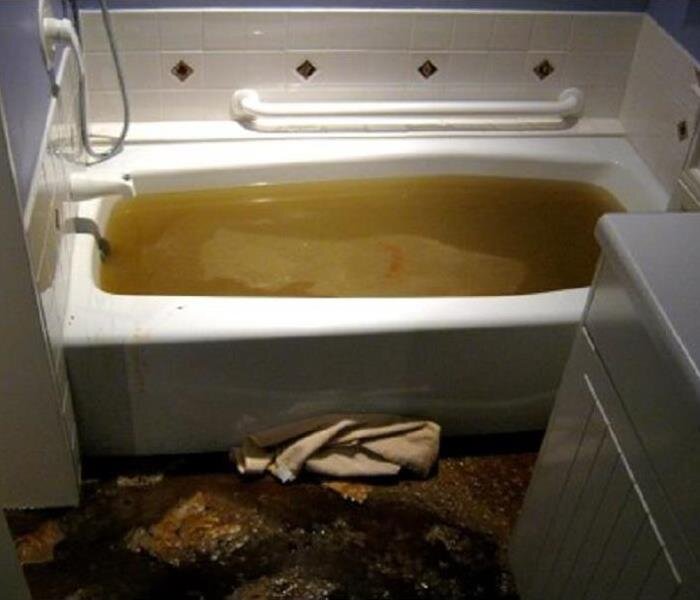Racial Inequality in Wastewater
By Jimi T Hardee, Rachel Major, and Ari Ochoa
If there is one phrase we as Americans have heard over and over again this year it’s this: wash your hands! In the time of a global pandemic, it’s good advice but what if the water in or around your own home was making you sick? What if the water you needed to run a business contaminated your products? Or sent your employees and customers to the hospital? Would it affect your productivity? Your health? Your daily life?
Not displaying correctly? View in Browser Home bathtub backed up with raw sewage. Original photo here.
It is now generally accepted that investing in water supply and sanitation services helps lift communities out of poverty, but we have yet to see significant efforts here in the United States to apply this economic thinking to our own people. To quote a Bloomberg article on the history of environmental racism in water “If you want clean water, don’t be Black in America.”
To understand why this is, we need to understand the realities of sanitation, especially in rural areas. Many of us who live in cities never really think about what happens to our water after it goes down the drain. Our homes are hooked up to municipal water grids and waste is pumped into the sewer. We pay for the water utility but ultimately keeping the treatment system working is someone else’s problem (even these systems are failing but that’s a subject for another newsletter). However, many people living in rural America start their days by walking out onto lawns bubbling over with sewage caused by failing septic systems. We’ve talked about the inherent issues with septic systems in past blogs and newsletters, but what we haven't touched on is how these issues disproportionately affect BIPOC in the United States.
Catherine Flowers interview with VICE on Lowndes County sanitation issues.
Catherine Flowers leads a campaign to fight diseases like hookworm caused by failing water sanitation infrastructure. Her work has brought her face to face with the appalling living conditions that are an everyday reality for many who live without access to effective water treatment. In interviews, Flowers has described bathtubs backed up with waste, homes flooded with raw sewage, even residences with sewage PVC pipes that empty right into their front yards. These scenes may sound as if they were playing out in some far-away nation in the developing world but they actually come from right here in the American “Black Belt.”
The region is named after the rich, black soil found there more than the demographics, but as of 2017 80% of America’s rural Black population live in the states that form the Black Belt. In Catherine Flowers’ home of Lowndes County, Alabama 72% of the population is Black. Flowers’ work started in 2002 when over two dozen Lowndes County residents were arrested for failing to fix their septic tanks - despite the fact that repairs cost more than what most of these residents make in a year.
Catherine Flowers in front of a pool of sewage in White Hall, Alabama. Original photo here.
To date, it is estimated that at least 50% of households in the county have failing septic systems, or none at all. In addition, most of the residents own their homes, which means they are responsible for maintaining their own septic system. But many of the homes in the county are mobile homes, often worth less than the staggering price tag of $30,000 for a working septic system suitable for the area. For most people living in Lowndes County, installing a new septic system is simply not financially possible.
All this untreated waste has turned Lowndes County into a hotbed of parasites. In 2017, a study found that nearly 35% of participants tested positive for hookworm and other diseases. Flowers brought this data to the Alabama Department of Health (ADH) as a call to action to help these communities improve their wastewater infrastructure. Unfortunately, she was ignored and conditions in Lowndes County have not improved. In a 2018 interview, Flowers commented that she thinks the ADH would have reacted differently if the participants in her study were white. Catherine Flowers has devoted nearly two decades to raising awareness of these failing septic systems, but the state and local governments in Alabama have demonstrated that they have no interest in supporting their Black communities.
Catherine Flowers testifies before congress in 2019.
Poverty, and the wastewater pollution connected with it, affects people of all backgrounds, but as we’ve discussed in our previous newsletter: poverty rates are much higher for the Black population. On-grid or off-grid wastewater treatment is expensive and too-often those that are in already vulnerable communities can’t afford it and are left behind.
With over 2 million Americans lacking proper sanitation infrastructure, the problem is growing across the US. Over the past two decades, Flowers has worked with communities from California to New York to Michigan. Testifying before Congress in 2019, Flowers estimated that 65% of the land in the US is not suitable for septic tanks, and pollution from failing septic tanks will only continue to accelerate if residents aren’t given assistance.
Sadly, the story of Lowndes County is happening in BIPOC communities all across the United States. In Hawaii, failing cesspools used for water treatment are threatening well water supply and spreading infection. Hawaii’s native population is one of the groups most affected by these failures of waste treatment infrastructure (or lack thereof). In East Palo Alto, a predominantly Black/Latinx community in the Silicon Valley, industrial incinerators were used to dispose of sewage up until last year, creating hazardous waste and shockingly high carbon emissions. These stories are playing out every day in some of America’s most at-risk communities and, without significant intervention, they are not likely to stop anytime soon.
Our failure to provide our communities of color with the basic necessities of life is a drop in the bucket that comprises institutional racism in America but it is important to understand how things like clean water access affect poverty and equity of opportunity. When we talk about the wealth gap in the USA, we have to recognize that there are barriers in place that prevent many BIPOC Americans from rising out of poverty, access to sanitation is one of those barriers. If we want to make a real effort to provide equal opportunities to all Americans, we have to begin by removing these systemic barriers.



